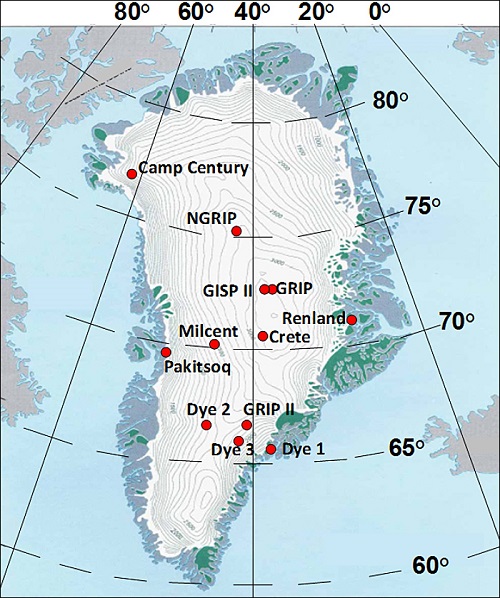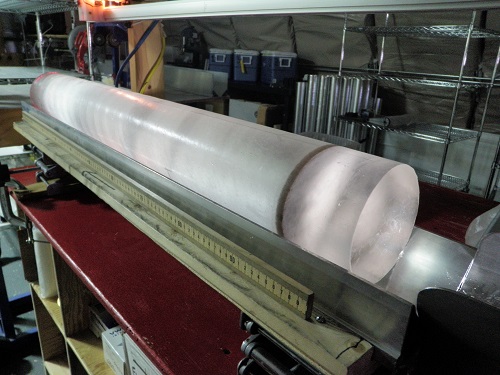From the eMail Bag: Abrupt Climate Change in Greenland's Past?
Posted on 25 January 2017 by David Kirtley
We occasionally receive excellent questions and/or comments by email or via our contact form and have then usually corresponded with the emailer directly. But, some of the questions and answers deserve a broader audience, so we decided to highlight some of them in a new series of blog posts.
In 2008 the U.S. Department of Energy's six National Laboratories began a new research program investigating "abrupt climate change" called IMPACTS: Investigation of the Magnitudes and Probabilities of Abrupt Climate Transitions. A blogpost on the Lawrence Berkeley Lab's website describing this program had this to say about the Younger Dryas, one of Earth's best-known periods of abrupt climate change:
[C]limate change has occurred with frightening rapidity in the past and will almost certainly do so again. Perhaps the most famous example is the reverse hiccup in a warming trend that began 15,000 years ago and eventually ended the last ice age. Roughly 2,000 years after it started, the warming trend suddenly reversed, and temperatures fell back to near-glacial conditions; Earth stayed cold for over a thousand years, a period called the Younger Dryas (named for an alpine wildflower). Then warming resumed so abruptly that global temperatures shot up 10 °C in just 10 years.
A Skeptical Science reader noticed this passage and wrote to us asking if this was accurate, especially that last sentence about an alarming 10 degree jump in just 10 years. I googled around a bit and came upon a NOAA Paleoclimatology webpage (also from 2008) which had a very similar passage:
About 14,500 years ago, the Earth's climate began to shift from a cold glacial world to a warmer interglacial state. Partway through this transition, temperatures in the Northern Hemisphere suddenly returned to near-glacial conditions. This near-glacial period is called the Younger Dryas, named after a flower (Dryas octopetala) that grows in cold conditions and became common in Europe during this time. The end of the Younger Dryas, about 11,500 years ago, was particularly abrupt. In Greenland, temperatures rose 10° C (18° F) in a decade.
The NOAA webpage had a graph of Greenland temperatures, snow accumulation and other climatological measurements. This graph also listed a number of references, including Alley, R.B. 2000. The Younger Dryas cold interval as viewed from central Greenland. Quaternary Science Reviews 19: 213-226. In that paper Alley described the abrupt increase in Greenland temperature at the end of the Younger Dryas as a "5-10°C step warming...with much of the change in a few decades or less".

Figure 1. Locations of Greenland Ice Core Stations. From: 800,000 Year Ice-Core Records of Isotopes 2H, 18O, and other isotopic species, Carbon Dioxide Information Analysis Center, Oak Ridge National Laboratory, U.S. Department of Energy.
The temperature recordings in question come from ice cores from the Greenland ice sheet, drilled by the Greenland Ice Core Project (GRIP) and the Greenland Ice Sheet Project II (GISP2) in the 1990s. As snow on the ice sheet accumulates and is compressed over time the compressed ice forms annual layers, which can be read much like the tree rings of a tree. By carefully analyzing the geochemistry of these layers scientists can find past temperatures, greenhouse gas concentrations and other climatic information:
...the ice cores collect indications of local climate (snow accumulation and temperature), regional climate (wind-blown materials from well beyond the ice sheet), and broader climates (trapped-bubble records of concentrations of trace gases involved in global biogeochemical cycles), which can be related to each other with little or no uncertainty. (Alley, 2000.)

Figure 2. One meter-long section of an ice core from the West Antarctic Ice Sheet. Note the dark layer of volcanic ash. Copyright Heidi Hoop (source: https://www.flickr.com/photos/ice_drilling/5595529294/in/photostream/)
So, to sum up, in 2000, Alley's research on Greenland found an abrupt local temperature increase of 5-10°C over a period of a few decades or less. By 2008, the NOAA Paleoclimatology page still described this as a local increase of 10°C (rather than a temp. range of 5-10°C) and had decreased the time frame to "a decade". Also in 2008, the Lawrence Berkeley Lab website had described this event as a global temperature increase of 10°C spanning a mere 10 years. What's going on here?
To answer that question I contacted Dr. Alley who responded that the temperature increase was "for Greenland, and applies moderately well around the North Atlantic, primarily as a wintertime change because there was a rapid shift from wintertime sea ice to wintertime open water in important regions." He continued:
I can provide lots of chapters and verses on all of this, but the skinny version is that when the abrupt shifts happened, they primarily involved circulation rather than greenhouse gases, they didn’t do a lot to global mean temperature, but they did do a lot to regional climates in many places, with large, rapid changes in north Atlantic temperatures, rapid shifts in monsoonal rains and in the edges of the tropical rain belts, smaller shifts in northern temperatures away from the North Atlantic, and lagged and opposite shifts in southern temperatures (so northern warming was followed by southern cooling).
So the Greenland ice cores record a regionally abrupt temperature change, not global. It would appear that the Berkeley Lab post mistakenly took the Greenland data as a proxy for a global average temperature jump. A small mistake perhaps, but one with large consequences. Much confusion and misinformation about Earth's climate can come from simple mistakes, sometimes intentionally. I have no doubt that the Berkeley Lab post was not trying to mislead its readers about the Earth's past climate changes. But I can imagine that someone could spin this as "proof" that the climate is always changing, even abruptly, so there is nothing for us to worry about concerning our present climate change. In fact, we have dealt with a similar misuse of the Greenland temperature records in this rebuttal: Most of the last 10,000 years were warmer.
The lesson here is to always check for references for facts which seem extraordinary, even for facts which come from trusted sources like Berkeley Labs. Google is your friend, and may be all you need to get started. Searching for answers to confusing information may lead back to the original research and the scientists who produced it.
In his response to me, Dr. Alley pointed me to a 2010 Dot Earth blogpost in which he answered similar questions about misunderstandings of the Greenland data. Here he shows how the past should be properly used to inform our future:
...that there have been large climate changes in the past without humans in no way demonstrates that humans are not now responsible. Many people have died naturally but murder still exists; it is up to the police to learn whether a given mortality was natural or not, and up to climate science to learn what is causing ongoing changes (and we have good confidence that most of what is happening to climatic global average surface temperature is being caused by humanity now). Similarly, demonstration that life, and humans, survived warmer temperatures in the past in no way shows that warmer temperatures in the future are good for us. If you don’t care about humans and other things with us here, making a big change in climate might be an interesting experiment. Evolution does respond to climate change and produce novel results. I just happen to have a personal bias (shared, I believe, by the majority of the six-plus billion people on the planet) that we should ask what is best for humanity, and pursue that. An opinion, surely, and not purely scientific, but that’s my bias.
Thanks to Dr. Alley for taking the time to answer our emailer's question.
I highly recommend Dr. Alley's book, The Two-Mile Time Machine: Ice Cores, Abrupt Climate Change and, Our Future which is a hands-on account of drilling ice cores on the Greenland and Antarctic ice sheets, and a "general-reader" account of the science gathered from studying them.
Finally, here is our Denial101x interview of Richard Alley:































 Arguments
Arguments






























Is is possible during the warming period, so much fresh water suddenly entered the North Atlantic it shut down the AMOC? Perhaps this would plunge the Northern Hemisphere back into an mini-glacial period until such time as all the fresh water was discharged, and the AMOC could rebuild itself. If this is the scenario, it could have repercussions for our future.
If we were to take all the necessary measures and avoid a disastrous climate change, the denialists would say it was all nonsense and revive business as usual. If we let things go, we will likely cause ourselves a series of serious disasters. We almost need some mid level disaster that is sufficient to get the attention of the deniers. I wonder if one will occur before it is too late.
Ubrew12,
Your scenario is one of the possible causes of the beginning of the Younger Dryas. See this post: Catching up with the Younger Dryas
There was a recent paper on this: Overlooked possibility of a collapsed Atlantic Meridional Overturning Circulation in warming climate, Liu, et al DOI: 10.1126/sciadv.1601666 And a write-up on it at Real Climate: The underestimated danger of a breakdown of the Gulf Stream System.
Yes, definite repercussions for our future.